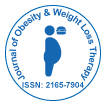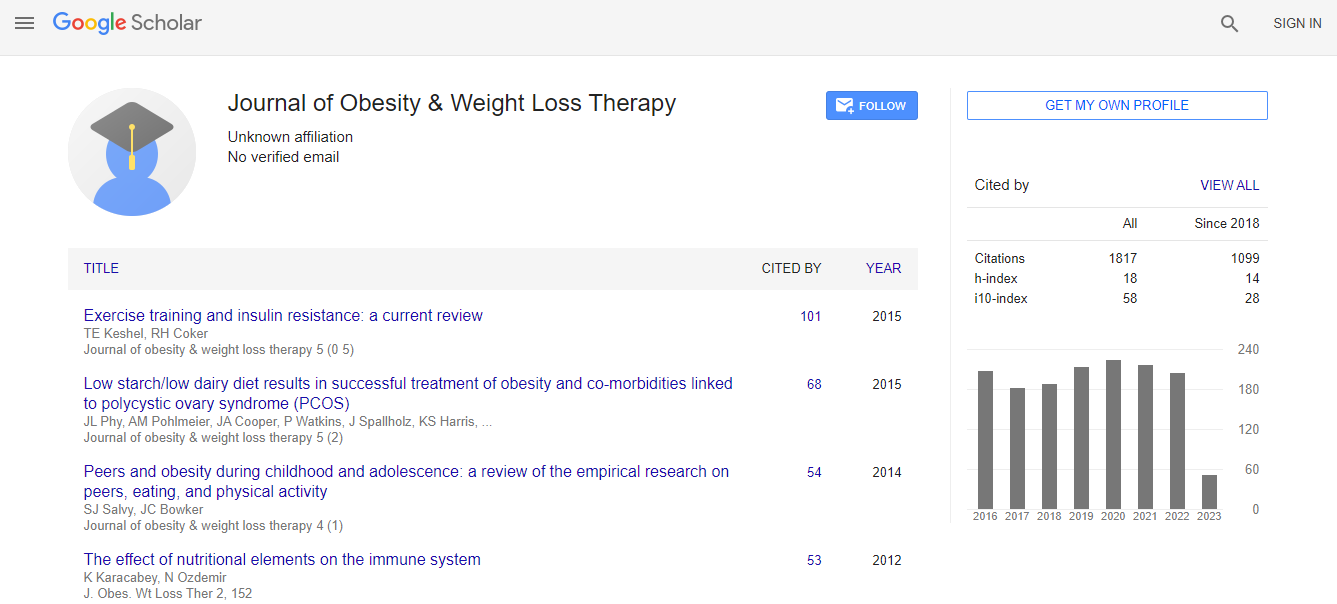Our Group organises 3000+ Global Conferenceseries Events every year across USA, Europe & Asia with support from 1000 more scientific Societies and Publishes 700+ Open Access Journals which contains over 50000 eminent personalities, reputed scientists as editorial board members.
Open Access Journals gaining more Readers and Citations
700 Journals and 15,000,000 Readers Each Journal is getting 25,000+ Readers
Google Scholar citation report
Citations : 2305
Journal of Obesity & Weight Loss Therapy received 2305 citations as per Google Scholar report
Journal of Obesity & Weight Loss Therapy peer review process verified at publons
Indexed In
- Index Copernicus
- Google Scholar
- Open J Gate
- Genamics JournalSeek
- Centre for Agriculture and Biosciences International (CABI)
- RefSeek
- Hamdard University
- EBSCO A-Z
- OCLC- WorldCat
- SWB online catalog
- CABI full text
- Cab direct
- Publons
- Geneva Foundation for Medical Education and Research
- Euro Pub
- University of Bristol
- Pubmed
- ICMJE
Useful Links
Recommended Journals
Related Subjects
Share This Page
Handgrip strength identificates type 2 diabetes mellitus patients with higher fracture risk
Joint Event on 12th International Conferences on Childhood Obesity and Nutrition & 3rd World Congress on Diabetes and Obesity
Federica Bellone
University Hospital of Messina, Italy
Posters & Accepted Abstracts: J Obes Weight Loss Ther
Abstract
Patients suffering from type 2 diabetes mellitus (T2DM) show increased fracture risk in comparison with healthy subjects. Bone mineral density (BMD), as measured by DXA, may be not enough to discriminate T2DM patients with higher fracture risk. Our aim was to investigate whether handgrip strength may be associated with bone health in T2DM patients. Anthropometric data and information about metabolic control and diabetic complications were recorded. Handgrip strength by dynamometer, FRAX derived 10-years probability of major osteoporotic fractures and hip fractures were also assessed. Bone evaluation was performed by a dual-energy X-ray absorptiometry (DXA) densitometer at the lumbar spine (L1-L4) and at the femoral neck; based on specific software, the trabecular bone score (TBS) was calculated. Lateral scan of thoracic and lumbar spine was assessed to investigate morphometric vertebral fractures (Vfx). 29 patients (female 65%) [median age 67 (60 to 70)] with T2DM were considered. Morphometric vertebral fractures were detected by DXA in 17% of patients without gender differences. The median ten years probabilities of fractures were 8.1% and 2.3% as for major osteoporotic or hip fracture respectively. Median femoral neck T-score value [-1.1 SD (-1.8 to -0.5)] was indicative of osteopenia, while lumbar spine T-score was observed even in the normal range [-0.8 SD (-1.5 to -0.1)]. TBS was positively associated with BMD at lumbar spine and femoral neck. Median handgrip strength value was 22.3 kg (18.9 to 31.3). At multiple regression analysis, handgrip strength predicted both lumbar (β=0.009, SE 0.0034, p=0.01) and femoral neck BMD values (β=0.006, SE 0.002, p=0.01). Age (β=-0.008, SE 0.002, p=0.007) and handgrip strength (β=0.01, SE 0.002, p=0.0001) were also independently associated with TBS score, after correcting for mean HbA1c values and time since T2DM diagnosis. These findings suggest that handgrip strength may be a reliable tool to investigate bone fragility in T2DM.Biography

 Spanish
Spanish  Chinese
Chinese  Russian
Russian  German
German  French
French  Japanese
Japanese  Portuguese
Portuguese  Hindi
Hindi 
